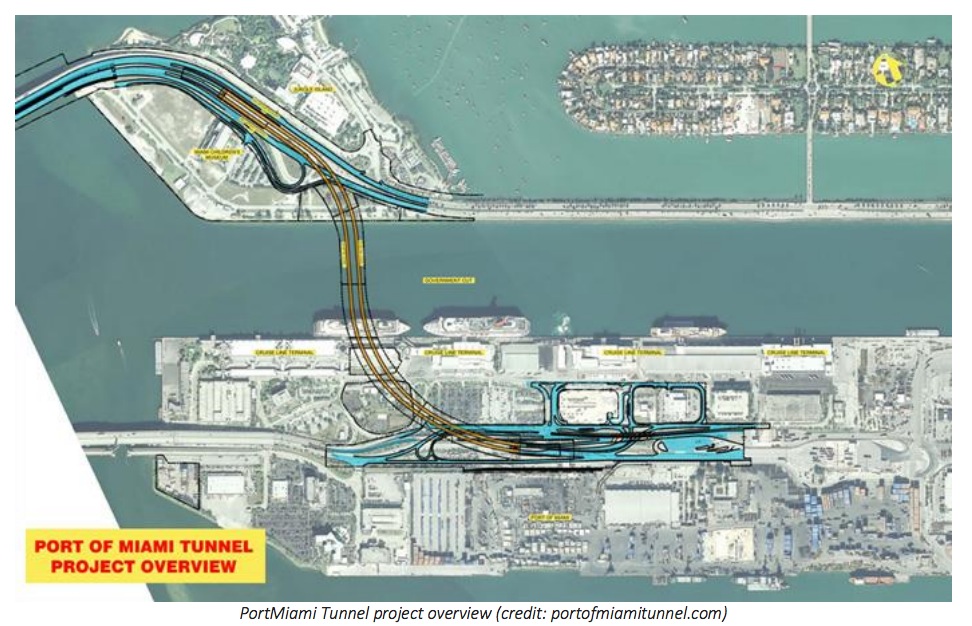LILLY & ASSOCIATES
INTERNATIONAL TRANSPORTATION LOGISTICS
Introduction
As construction teams and “for hire” signs first began to flood Miami-Dade County just six years ago in 2009, it signaled the beginning of an ambitious infrastructure project that would culminate in the completion of a landmark tunnel in Miami. The tunnel, which was designed in an effort to reduce traffic congestion around PortMiami, finally opened its doors (or rather raised its gates) to the public on August 3, 2014. Now that the tunnel has been fully operative for just over a year, it is the perfect time to reflect on how this colossal venture has affected city operations and improved the life of South Floridians and visitors alike. From creating jobs and clearing traffic, to boosting the economy, the tunnel has plenty to say for itself. Thousands of people drive through the underwater passageway each day, but most give little more than a passing thought to the endeavors that allowed the tunnel to take its final form. A great deal of planning went on behind the scene, and hundreds of officials came together to strategize on ways not just to construct a tunnel, but to launch a one-of-a-kind project that would serve as a model for how such large-scale infrastructure tasks, combined with a few novel ideas and a lot of hard work, could serve the local community and pay back their tax dollars many times over.
What Makes Miami Different
PortMiami is one of the most important economic centers in the United States. Not only is it the top seaport in Florida, it is the 11th largest cargo port in the nation. Miami is widely considered the “cruise capital of the world,” serving as a gateway to the Caribbean islands, Central America, and other top vacation destinations. The port is responsible for $15 billion a year in imports and exports, and $18 billion in total economic output. More than a dozen shipping companies regularly service the port, while cruise lines whisk over four million passengers a year off to exotic destinations. While this description paints a glamorous picture of a seaside city bustling with tourists and commerce, the port’s popularity has also made the region susceptible to painful congestion.
Congestion Issues
Just a few years ago, PortMiami suffered from traffic problems that rivaled downtown Manhattan. More than 16,000 cars and trucks traverse the streets surrounding the port every day, and traffic from cargo trucks makes up more than a quarter of that figure. Prior to the tunnel project, the existing bus and vehicle routes were struggling to support the massive weight of this congestion and inhibiting further growth in the region. The city’s central business district, a portion of which lies proximal to the port, was also restricted in its development due to the extensive traffic that clogged roadways and stymied commercial growth. And traffic patterns in Miami are distinct, even from those of other big cities. In addition to typical workday and rush hour traffic, South Florida experiences a significant uptick in congestion in the evening, especially on weekends during peak nightlife hours.
Decades in the Making
Most area residents would have quickly agreed that a change was in order, but what most did not realize was that Miami-Dade County had been discussing viable solutions since the 1980s. Thirty years ago the venture was dubbed the “Port of Miami Transportation Improvement Plan,” but lacked clear vision of how the actual plan would become reality.
It was not until the year 2000 that the Federal Highway Administration approved the project, and it would be another decade before construction crews finally broke ground on the site.
Planning Stages
What started as a grass field would soon become home to one of the greatest engineering feats in South Florida, responsible for removing nearly 1.5 million trucks from the streets of downtown Miami.
The blueprint for the tunnel was ambitious, to say the least. The plan was to construct a new road that would dip under Biscayne Bay, a waterway between Watson and Dodge Island, effortlessly whisking drivers from the MacArthur Causeway to PortMiami. Today, the tunnel seems like a natural continuation of the surrounding highway, but six years before its opening, it was not so obvious how a construction crew would initiate such a project on some of the busiest roads in South Florida. As Miami Access Tunnel CEO Chris Hodgkins described the process, “It was like working in a glass bubble.”
Unable to shut down the roadways during construction, project authorities had to instead revert the traffic coming across the MacArthur Causeway Bridge 100 feet to the south. They ended up expanding the roadways from three to four lanes in each direction so as not to disrupt traffic, as well as installing new pylons and girders on the bridge. This sounds like a construction project in and of itself, and yet it was all just prep work. The construction team temporarily reconfigured the roads on Dodge Island so that drivers could make a seamless transition to the port, even during construction. Workers then prepared new roads that crewmembers could install in less than twenty-four hours; continuing the effort to minimize the operation’s impact on port traffic.
Download full version (PDF): PortMiami Tunnel – The New Standard in Transportation Infrastructure
About Lilly & Associates
www.shiplilly.com
…LILLY’s work can be explained by shipping products from point A to point B, usually from a supplier/manufacturer to their end user (and everything in between). This involves ocean shipping via large vessels (full containers and loose cargo), air cargo and all ground freight, including trucking, drayage and rail.
Tags: FL, Florida, Lilly & Associates, Miami, Port of Miami







 RSS Feed
RSS Feed